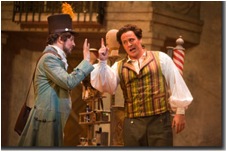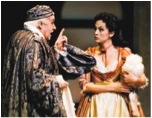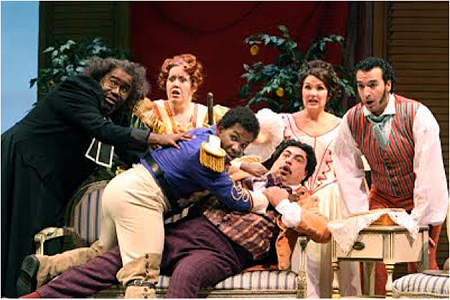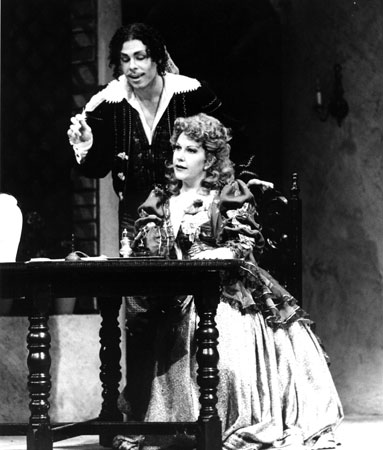 |
|||
|
Reviews The Barber of Seville Photo: Mathew Staver Stage director for Opera Colorado's current production, David Gately, an experienced hand at this piece, wisely leaves the setting untouched while cleverly building on Figaro's mastery of human psychology and timing that, along with some splendid performances, makes this a must-see for opera buffa buffs and neophytes alike. — Coloradodrama.com
Photo: Isabel Leonard (Rosina) and Thomas Hammons (Dr. Bartolo) in Opera Colorado's "Barber of Seville." (Matthew Staver)
For Opera Colorado's traditional production of the opera — boasting a well-cast ensemble in mostly debut performances — veteran director David Gately emphasizes the heart and humor of a plot that depicts the buffoonery of nobles manipulated by their subjects. For this production at the Ellie Caulkins Opera House, Gately eschews elaborate or modernist sets and costumes in favor of an atmosphere that relies predominantly on the cohesion of its cast to make the popular narrative fresh, entertaining and relevant to modern sensibilities. Gately’s staging supports the wit and subtle dramatic expressions of each character. For example, a hilarious highlight of the production comes at the end of Act 1 in which a noisy argument between Doctor Bartolo and Count Almaviva attracts a troop of officers (well- played by the all-male chorus). A scuffle ensues, and the crescendo of chaotic events is choreographed in side-splitting slow motion in which each punch and blow takes on an exaggerated magnitude — much like watching a replay of a street fight. Experience counts. That is certainly true in the case of veteran David Gately, who directed Opera Colorado's production of Il Barbiere di Siviglia. It is, reportedly, his thirty-first staging of the work, and by now, he has clearly developed a fun, well-honed approach to the enduring masterpiece. Gately unlocked Barbiere's full comic potential, generating choruses of laughs and sending the audience home chattering with satisfaction (seen Feb. 6). There were no jarring updates or other conceptual conceits. Indeed, all the action took place on a rotating, traditional set, originally created in the 1970s by John W. Stoddard for Houston Grand Opera. Gately trusted the inherent power of Rossini's music and Cesare Sterbini's libretto and simply amplified it, injecting an abundance of clever sight gags and making sure the action never flagged. His most original touches were turning Figaro into a kind of onstage director, who could start or stop the action with a snap of his fingers, and the madcap, slow-motion finale to Act I. The production also required singers who had a flair for comedy and were willing to buy into Gately's ultra-physical, intricately interwoven staging. This fine cast scored on both counts. — Kyle Macmillan – Opera News The Barber of Seville Photo: Eric Owens, Cynthia Hanna, Lawrence Brownlee, Donato DiStefano, Silvia Tro Santafe, Simone Alberghini (photo: Karin Cooper)
Comedy, as every actor avers at some point, is hard. Harder than drama, even. Comedy can be just as tough for opera singers, especially when it comes to popular works where the jokes have few surprises left in them. — The Baltimore Sun
— lonarts
— The Examiner
— The Washington Post
Photo: Joyce DiDonato as Rosina, Daniel Mobbs as Figaro
Here, however, clarity is maintained and even heightened. As the music quickens and the crescendos take hold Gately puts the entire spectacle in slow motion and freeze frame: an almost literal evocation of Rossini's "Fredda ed immobile"....it fits elegantly into the director's overall scheme of suggesting alternative perspectives on the opera's accelerating absurdities. Several of the production's more enticing bits belonged to Bertha. Also, Bertha's relationship with Ambrogio was worth studying: it was subtext, perhaps, yet somehow essential. — Louisville Courier-Journal
|



